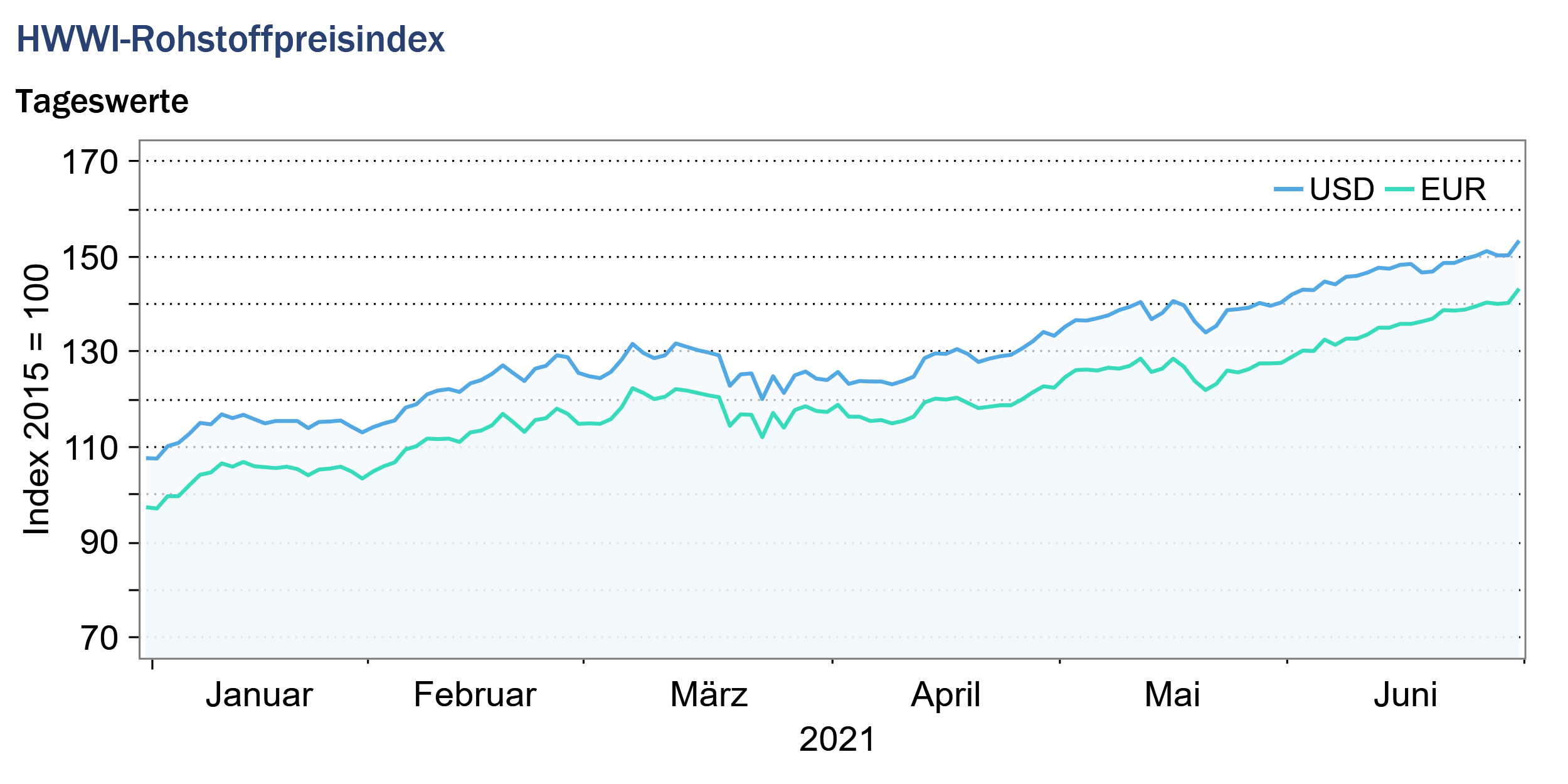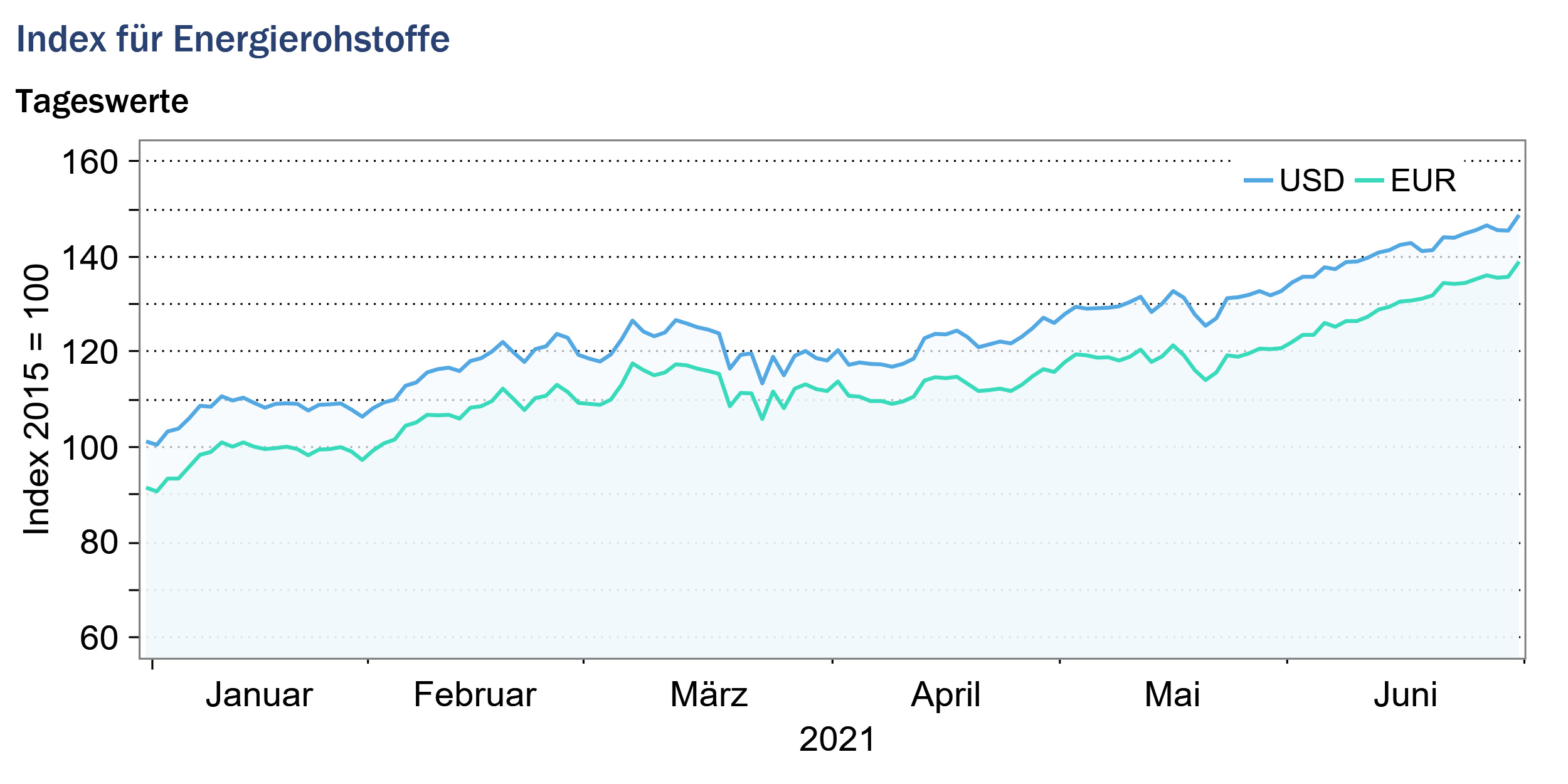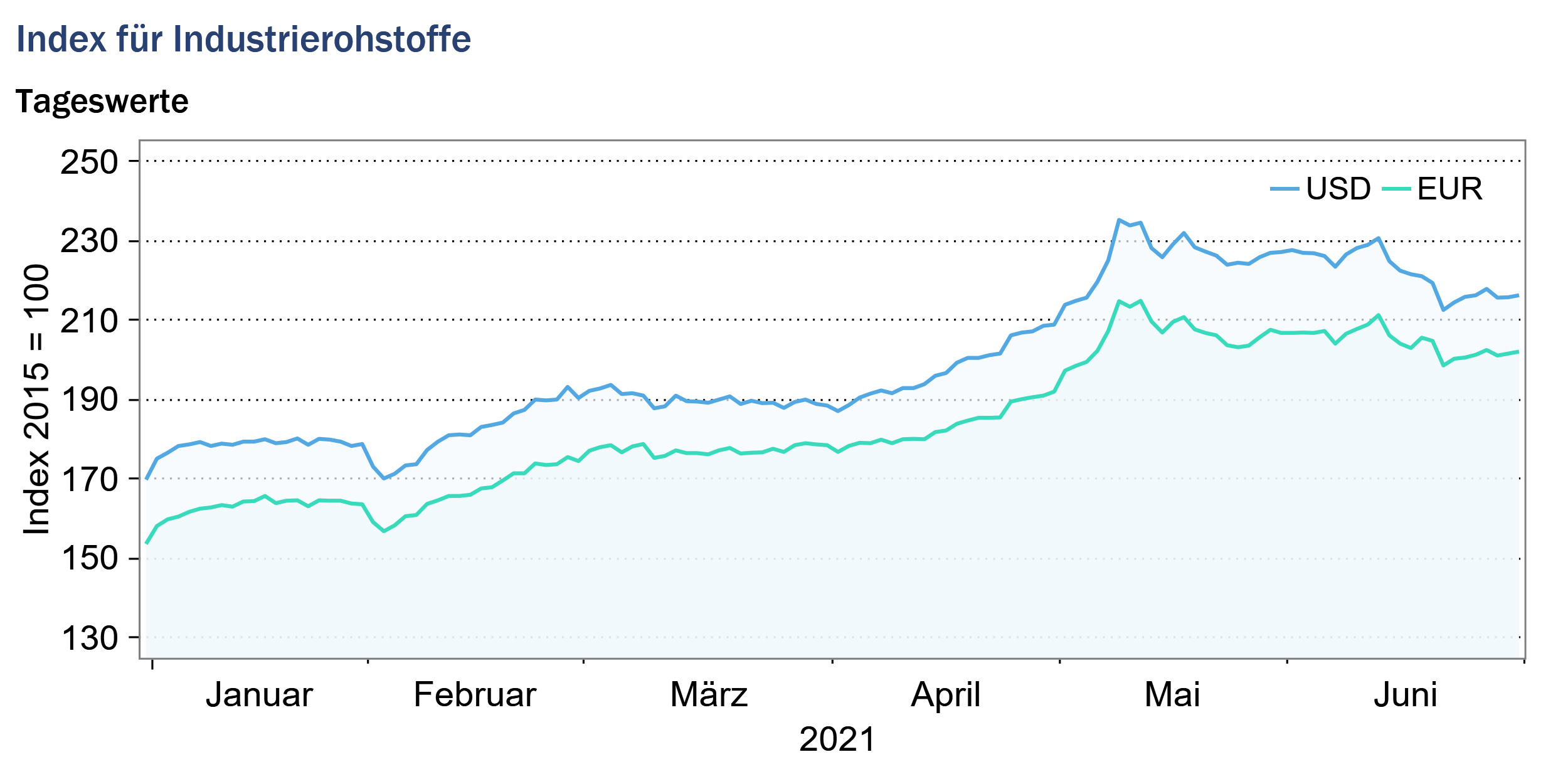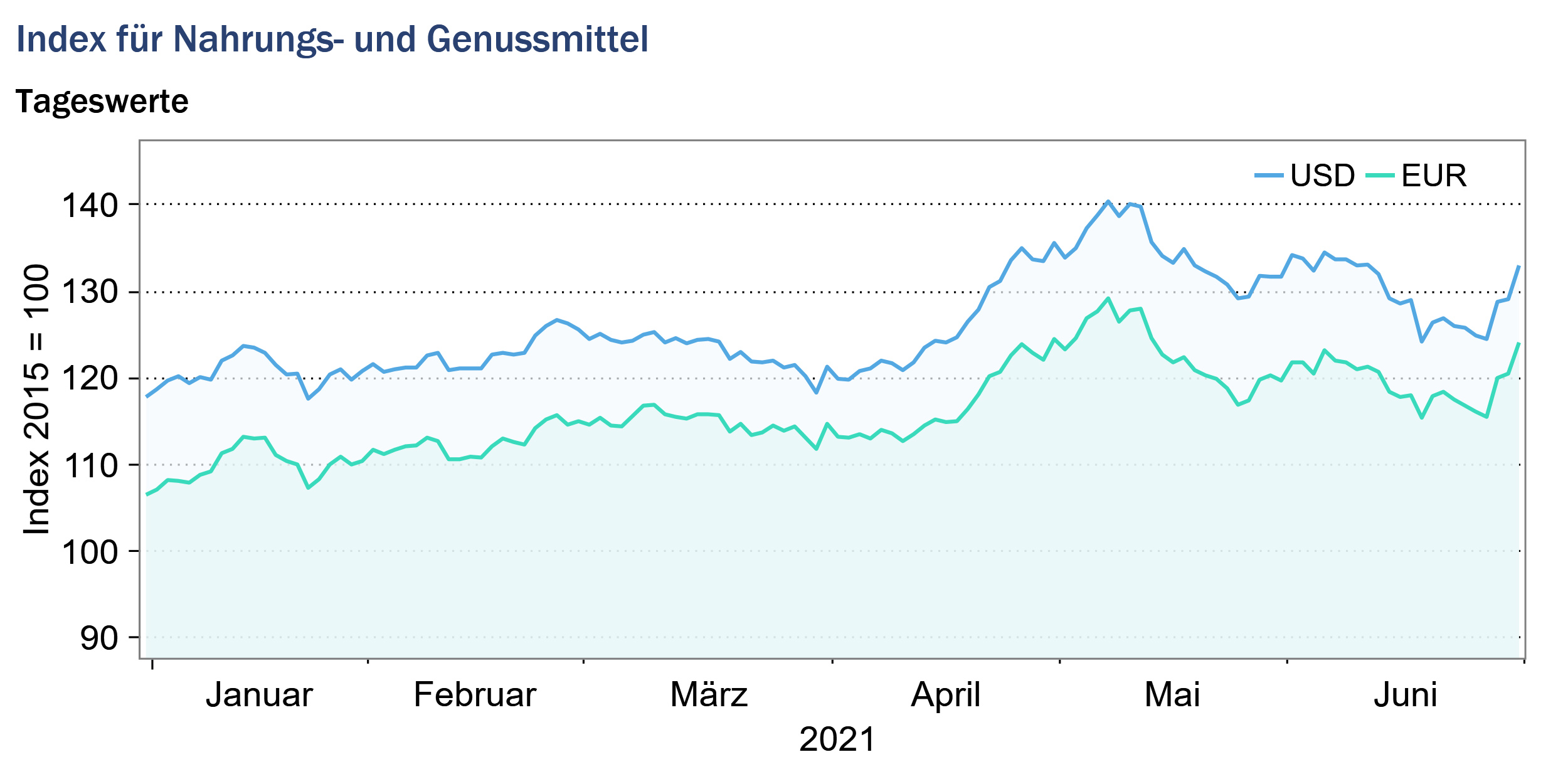HWWI Commodity Price Index continues to increase in June
- HWWI overall index rose by 6.7 % (US dollar basis)
- Crude oil prices increased by 8.3 %
- Sawn wood prices fell by 16.2%(Hamburg, July 16, 2021)
The HWWI commodity price index rose by an average of 6.7% in June compared with the previous month and was thus 90.2% higher than the corresponding monthly figure for the previous year. The increase in the overall index in June was driven in particular by the rise in energy commodity prices. By contrast, the strong positive price trend in the index for industrial raw materials, which has been continuing for several months, was interrupted for the first time in June. On average, industrial raw materials recorded a slight price decline compared with the previous month, but prices remained at a high level. The markets for grains and vegetable oils also saw sharp price declines in June. By contrast, prices for luxury food increased on average compared with the previous month.

Index for energy raw materials: +8.8 % (euro basis: +9.7 %)
Crude oil prices recorded an upward trend in June. Prices for European benchmark grade Brent topped US$70 per barrel at the beginning of the month and ended the month just below US$75 per barrel. Prices for the U.S. reference grade WTI moved in parallel with the Brent price, with an average difference of around minus 2 U.S. dollars. The recovery of the global economy and the associated increase in demand for crude oil continued to have a price-driving effect on the crude oil markets in June. However, global vaccination progress, which provided a positive outlook for the world economy, was offset by the rapid spread of virus mutations. Thus, concerns about a renewed imposition of lockdown measures in June increased uncertainty in the crude oil markets.
In addition, price developments on the crude oil market in June were influenced by expectations about the outcome of the negotiations between the OPEC+ countries scheduled for early July. Once again, the OPEC+ alliance is struggling to agree on a joint production strategy. While Saudi Arabia still aims to keep the oil price stable by cutting supply, Russia is in favor of increasing crude oil supply.
The markets for coal saw sharp price increases in June. While South African coal prices rose by an average of 12% month-on-month, Australian coal prices increased by as much as 24.8% on average for the month. Although there is a global push to decarbonize the economy, coal prices are currently at highs that have not been exceeded in 10 years. Due to China’s ban on Australian coal imports, coal supply chains have had to be reorganized. China is relatively self-sufficient in coal compared to other commodities, importing only about 20% of its own coal consumption. In absolute terms, however, China’s imports play a major role on the world market. Distorted trade flows due to the trade dispute between China and Australia and a weakened supply of coal due to mine closures in Colombia and floods in Indonesia and Australia drove up coal prices in June.
The rise in coal prices was further supported by rising natural gas prices. U.S. and European natural gas prices continued to rise sharply in June compared with the previous month. While the U.S. natural gas price increased by an average of 10.5%, the price of European natural gas rose by 6.5% compared with the previous month. In addition to the global economic recovery, natural gas prices benefited from hot temperatures in the USA and the associated consumption of natural gas for air conditioning. In addition, natural gas supply continues to be weakened by the lockdown measures due to the pandemic.
Overall, the energy raw materials sub-index rose by 8.8 % (euro basis: 9.7 %) to 141.6 points(euro basis:130.4 points).

Index for industrial raw materials: -1.8 % (euro basis: -1.0 %)The subindex for industrial raw materials is divided into the index for agricultural raw materials, the index for nonferrous metals and the index for iron ore and steel scrap. In June, the upward trend in prices for most industrial raw materials was interrupted for the first time in months, and the markets for nonferrous metals and lumber recorded price declines.
The sub-index for nonferrous metals fell by an average of 1.9% in June compared with the previous month, due to price declines on the markets for copper and zinc. To counter the extreme price increases on the copper markets in recent months, China sold copper from government stocks. As a result, copper prices fell by an average of 5.5% from the previous month. The Chinese authorities announced the same course of action for aluminum and zinc.
The iron ore markets also saw only slight price increases in June compared with the previous month. The reason given for the development on the iron ore markets is that China has to reduce its steel production in order to meet its CO2 emission targets.
By contrast, prices for hides recorded a particularly sharp increase. Prices for hides had fallen sharply due to the collapse in demand for leather goods at the start of the Corona crisis. As a result of the global recovery, demand for leather goods is now rising again, with the furniture and automotive sectors in particular showing increased demand for leather.
Prices on the pulpwood and lumber markets also fell on average in June after rising sharply in previous months. U.S. sawmills, which have been unable to meet the rising demand for construction lumber for months, have now expanded their production capacities. In addition, it can be observed that construction projects have been postponed due to the increase in raw material prices, which also weakened demand.
Overall, the index for industrial raw materials fell by a monthly average of 1.8 % (euro basis: 1.0 %) to 221.8 points (euro basis:204.5 points).

Index for food and beverages: -3,4 % (euro basis: -2.7 %)The index for food and beverages fell by an average of 3.4% in June compared with the previous month. While the sub-indices for grains and for oilseeds and oils recorded price declines, the sub-index for luxury foods rose on average for the month.
Prices for grains such as corn, wheat and barley, most of which have seen price increases in recent months, fell on average in June compared with the previous month. After a long drought, rainfall in harvesting regions led to an improvement in crop forecasts and thus to a decline in prices.
In addition, a court ruling in the USA in June depressed prices for raw materials used to produce biofuels, such as corn and vegetable oils. Oil refiners can now apply for exemptions from the federal law requiring the blending of ethanol and other biofuels. Prices for sunflower oil in particular reacted with sharp declines.
By contrast, prices for luxury foods rose on average in June compared with the previous month. Prices for coffee and tea in particular rose compared with the previous month and continued to be driven by unfavorable weather conditions in the harvesting regions. Following prolonged drought, frost occurred in key Brazilian growing regions, which could affect future coffee and sugar harvests. In addition, demand continued to be supported by the global economic recovery.
The price of cocoa continued to fall in June compared with the previous month. This was due to high supply, mainly from Ivory Coast and Ghana, and continued weakened demand due to the Corona crisis.
Overall, the food and beverages index fell by a monthly average of 3.4 % (euro basis: -2,7%) and stood at 129.9 points (euro basis: 119.6 points).

Source: www.hwwi.org
